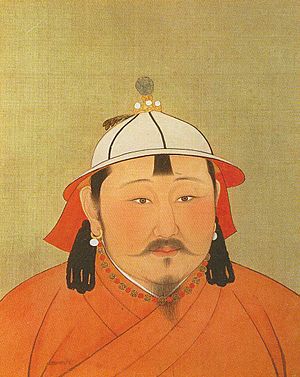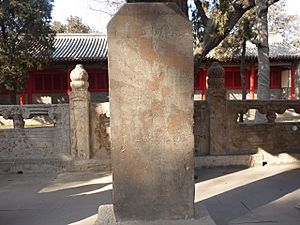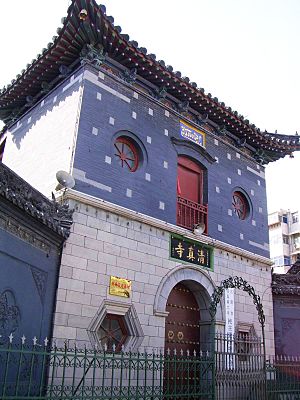Temür Khan facts for kids
Quick facts for kids Emperor Chengzong of Yuan元成宗 Öljeytü Khan 完澤篤汗 ᠥᠯᠵᠡᠶᠢᠲᠦ ᠬᠠᠭᠠᠨ |
|||||||||||||||||||||||||
|---|---|---|---|---|---|---|---|---|---|---|---|---|---|---|---|---|---|---|---|---|---|---|---|---|---|
| Khagan of the Mongol Empire (nominal, due to the empire's division) Emperor of China (2nd Emperor of the Yuan dynasty) |
|||||||||||||||||||||||||

Portrait of Temür Khan. Original size is 47 cm wide and 59.4 cm high. Paint and ink on silk. Now located in the National Palace Museum, Taipei, Taiwan.
|
|||||||||||||||||||||||||
| Emperor of the Yuan dynasty | |||||||||||||||||||||||||
| Reign | 10 May 1294 – 10 February 1307 | ||||||||||||||||||||||||
| Coronation | 10 May 1294 | ||||||||||||||||||||||||
| Predecessor | Kublai Khan | ||||||||||||||||||||||||
| Successor | Külüg Khan | ||||||||||||||||||||||||
| Born | 15 October 1265 | ||||||||||||||||||||||||
| Died | 10 February 1307 (aged 41) Khanbaliq, Yuan China |
||||||||||||||||||||||||
| Empress | Empress Shirindari of Khongirad clan (m. 1285–died 1305) Empress Bulugan of Baya'ut clan (m. 1295–1307) |
||||||||||||||||||||||||
|
|||||||||||||||||||||||||
| House | Borjigin | ||||||||||||||||||||||||
| Dynasty | Yuan dynasty | ||||||||||||||||||||||||
| Father | Zhenjin | ||||||||||||||||||||||||
| Mother | Kokejin (Bairam egchi) | ||||||||||||||||||||||||
Öljeytü Khan, also known as Temür or Emperor Chengzong of Yuan, was an important ruler in Chinese history. He was the second emperor of the Yuan dynasty in China, ruling from 1294 to 1307. He was also considered the sixth Great Khan of the Mongol Empire. However, the Mongol Empire was already divided by then, so his power over all Mongol lands was mostly in name only.
Temür was the grandson of Kublai Khan, who founded the Yuan dynasty. During his time as ruler, he managed to get all the different Mongol states to recognize him as their leader, even if it was just a formal title. He respected Confucianism, a major philosophy in China, and stopped plans to invade places like Burma, Vietnam, and Japan. Despite his efforts, his rule faced problems with corruption and how the government was run.
Contents
Early Life and Rise to Power
Temür was born on October 15, 1265. His name means "blessed iron Khan" in Mongolian. He was the third son of Zhenjin and Kökejin. Temür's grandfather, Kublai Khan, was the first emperor of the Yuan dynasty. Temür's father, Zhenjin, was supposed to be the next ruler, but he passed away in 1286.
Temür helped his grandfather Kublai Khan put down a rebellion led by a Mongol prince named Nayan in 1287. After this, Temür was put in charge of guarding an important area in the east. In 1293, Kublai Khan made Temür the princely overseer of Karakorum, a historic Mongol capital.
When Kublai Khan died in 1294, a special meeting called a kurultai was held to choose the next emperor. Since Temür's older brother had also passed away, it came down to Temür and his other brother, Gammala. They had a competition to see who knew more about the sayings of Genghis Khan, the famous Mongol leader. Temür won and became the new emperor.
Temür Khan's Rule
Temür Khan tried to follow the good policies of his grandfather, Kublai Khan. He managed to get all the different parts of the Mongol Empire to formally accept him as their highest leader. However, he struggled to fix the problems of corruption and poor management that were common in the government at the time.
Temür Khan showed great respect for Confucianism and its scholars. Soon after he became emperor, he ordered that Confucius be honored. He also appointed important officials who were close to Confucian scholars. Temür also gave new guards and wealth to his mother, and her palace became a powerful center for her family for many years. His government included both Mongol and non-Mongol officials, including Chinese administrators and Muslim financial experts.
The number of Tibetans working in the government slowly grew. Temür Khan also changed his grandfather's policy against Taoism, another important Chinese philosophy. He appointed a Taoist leader to a high position.
Temür Khan did not want to put more taxes on his people. He often gave tax breaks to different parts of the Yuan dynasty. For example, he removed taxes for a year in the capital cities of Khanbaliq (modern Beijing) and Shangdu. He also exempted Mongol commoners from taxes for two years. However, the government's money situation got worse, and the use of paper currency became less trusted. Corruption among officials also became a bigger problem.
Towards the end of Temür Khan's rule, a long war between the Yuan dynasty and the western Mongol khanates (like the Golden Horde and Ilkhanate) finally ended around 1304. This war had lasted over 30 years and caused the Mongol Empire to split permanently. Temür Khan was recognized as the formal leader of these western khanates. Even though this peace did not last very long, it showed that the Yuan dynasty was seen as the most important Mongol power for a few decades.
Foreign Relations in Southeast Asia
Soon after becoming emperor in 1294, Temür Khan stopped plans for more invasions of Japan and Vietnam. He sent messengers to Japan and Champa (a kingdom in Southeast Asia) to ask them to formally accept his rule. Champa agreed, but Japan refused.
Rulers from Vietnam, Burma, and Sukhothai (in modern Thailand) visited Khanbaliq to show their respect to Temür Khan between 1295 and 1300. When the prince of Burma visited, Temür Khan stopped a planned military campaign against Burma. He told his officials, "They are our friendly subjects. Do not attack their people." He also released envoys from Vietnam to show his good intentions, and Vietnam began sending tribute missions. However, Temür's government still had to deal with rebellions in the southwestern mountains.

In 1297, Temür Khan sent part of the Yuan army to Burma to help a Burmese prince. They successfully pushed back invaders from the Shan people. Temür also received visitors from Siam (Thailand) and Cambodia. He sent a traveler named Zhou Daguan to Cambodia in 1296, who later wrote a famous book about his journey.
In 1299, a Burmese prince named Athinkaya killed his brother, who had submitted to Temür Khan. In 1300, Temür Khan launched a military attack on Burma to punish Athinkaya. Shan warlords also raided Yuan lands. Temür sent his army from Yunnan to stop them. Even though these campaigns were difficult, Athinkaya and the Shan lords eventually submitted to Temür Khan. After Temür Khan ordered his army to leave Burma, parts of Burma came under Thai rulers who formally paid tribute to the Yuan dynasty.
Death and Succession
Temür Khan died in the capital city of Khanbaliq on February 10, 1307. He did not have a male heir because his only son, Teshou, had died a year earlier.
After his death, his nephew Khayishan became the next emperor, known as Külüg Khan. Before becoming emperor, Khayishan made an agreement that his younger brother, Ayurbarwada, would be the next crown prince. This agreement was later broken.
Family
- Empress Shirindari (died 1305)
* Prince Deshou (died 1306), his only son.
- Empress Bulugan
- Empress Huteni
- Unknown
* Princess Chang, named Yilihaiya * Princess Zhao, named Aiyashili * Princess Lu, named Puna
See also
 In Spanish: Timur Kan para niños
In Spanish: Timur Kan para niños
- List of emperors of the Yuan dynasty
- List of Mongol rulers
- List of rulers of China
- Yuan dynasty in Inner Asia


